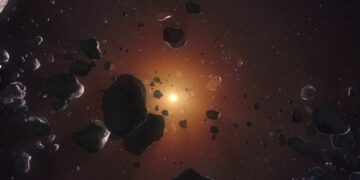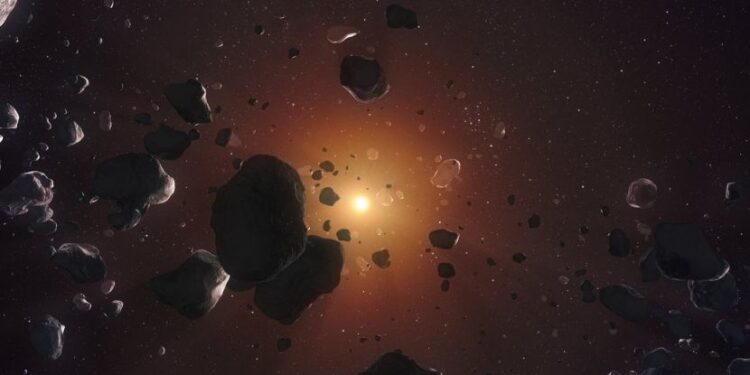Astronomers have recently discovered something unexpected at the far reaches of our Solar System, Could there be more lurking in the dark, uncharted regions beyond Neptune? Let’s explore this intriguing possibility and what it could mean for the future of space exploration.
Revisiting the Kuiper Belt: A New Perspective
The Kuiper Belt, located beyond the orbit of Neptune, has been a topic of fascination for decades. Stretching from about 30 to 50 AU from the Sun, this region is filled with icy bodies and dwarf planets like Pluto and Eris, remnants from the early Solar System. KBOs are considered some of the most pristine objects because they have remained relatively unchanged for billions of years, offering a unique window into the Solar System’s early days. However, recent observations challenge our understanding of this region.
Using the Subaru Telescope in Hawaii, astronomers have discovered 11 new KBOs far beyond the known boundary of the Kuiper Belt, in a region extending from 70 to 90 AU. This unexpected rise in the density of KBOs, coupled with a near-empty gap between 55 and 70 AU, suggests that the Kuiper Belt might not be a continuous structure but rather consists of two distinct components.
The Science Behind the Discovery
The discovery was made possible through advanced observations by the Subaru Telescope’s Hyper Suprime-Cam, a powerful instrument that captures wide-field images of distant cosmic objects. By analyzing the light from these newly discovered KBOs, astronomers could estimate their distance and density, revealing a surprising clustering of objects far beyond what was thought to be the edge of the Kuiper Belt.
Planetary scientist Fumi Yoshida from the University of Occupational and Environmental Health Sciences in Japan commented on the significance of this finding: “If this is confirmed, it would be a major discovery. The primordial solar nebula was much larger than previously thought, and this may have implications for studying the planet formation process in our Solar System.” This statement underscores how such a discovery could alter our understanding of the early Solar System’s formation conditions, suggesting that it may have been far more extensive than previously believed.
Implications for the Solar Nebula and Planet Formation
The detection of a possible second component of the Kuiper Belt implies that the Solar System’s primordial solar nebula—the cloud of gas and dust from which the Sun and planets formed—was larger and more complex than earlier models suggested. This has significant implications for our understanding of the processes that shaped the formation of planets and other celestial bodies in our Solar System. If there is indeed an outer component of the Kuiper Belt, it could indicate that the solar nebula extended farther and had more material than we thought.
This idea aligns with observations of other planetary systems in the galaxy, where astronomers have detected gaps and rings in the protoplanetary disks surrounding young stars. These gaps are believed to be caused by the gravitational influence of forming planets or by other dynamic processes within the disk. Wesley Fraser of the National Research Council of Canada, who led the study, notes that the newfound gap between the inner and outer Kuiper Belt is similar to those seen in other planetary systems. This could mean our Solar System is not as unique as we previously believed and that the processes shaping planetary systems are more universal.
Why This Discovery is Significant
The potential discovery of a hidden structure in the Kuiper Belt challenges long-held beliefs about the Solar System’s outer regions. For many years, scientists considered the Kuiper Belt to be relatively small and compact compared to those around other stars, but this new finding suggests otherwise. If our Kuiper Belt indeed extends farther and has a second, more distant component, it would bring our Solar System’s structure more in line with what we observe elsewhere in the galaxy. This has major implications for our understanding of planetary formation and evolution.
For example, a more extended Kuiper Belt could mean that the early Solar System had more material to work with, potentially influencing the formation and migration of the giant planets like Jupiter and Saturn. It could also affect our understanding of the Sun’s early environment and its impact on the solar nebula. The finding challenges previous models of Solar System formation and suggests that there might be more to learn about how our cosmic neighborhood came to be.
Future Research and Observations
While the discovery is exciting, more research is needed to confirm the existence of this potential second component of the Kuiper Belt. Astronomers plan to continue monitoring the newly discovered KBOs’ orbits to gather more data on their distribution and density. Observations using more advanced telescopes, such as the James Webb Space Telescope (JWST), could provide more detailed insights into these distant regions of the Solar System. By understanding the properties and behaviors of these KBOs, scientists hope to gain a clearer picture of the outer Solar System’s structure and its evolution.
Alan Stern, Principal Investigator of the New Horizons mission, describes this finding as “a groundbreaking discovery revealing something unexpected, new, and exciting in the distant reaches of the Solar System.” This discovery could pave the way for new theories and models of the Solar System’s outer regions, influencing everything from our understanding of planetary dynamics to the potential for life on other worlds.
Conclusion: A New Era of Exploration at the Solar System’s Edge
The potential discovery of a hidden structure in the Kuiper Belt marks an exciting new chapter in our exploration of the Solar System. It challenges traditional notions of where our Solar System ends and offers a new perspective on its formation and evolution. As astronomers continue to explore these distant regions with advanced technologies, we are likely to uncover more surprises that reshape our understanding of the cosmos.
This discovery is a testament to the dynamic and ever-evolving nature of space science. It reminds us that even in our cosmic backyard, there are still many mysteries waiting to be uncovered. By pushing the boundaries of what we know, we are not only learning more about the universe but also about our place within it. As we venture further into the unknown, each discovery brings us one step closer to understanding the vast, interconnected web of galaxies, stars, and planets that make up our universe.
Reference: https://www.sciencedirect.com/topics/earth-and-planetary-sciences/kuiper-belt



















